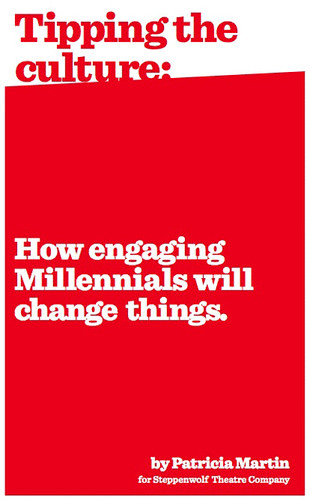Note from Beth: Last Spring, Allison Fine and I did an evaluation report for the Case Foundation on the America’s Giving Challenge 2009. One of the ideas we explored is it possible through social media to share some of the findings in a conversational way to help prod more insights from the field. We experimented with “Conversational Case Studies” and found that conversation in the comments helped improve the richness of the final report.
That model uses social media a mechanism to give feedback. Another way to use social media is for the sharing and distribution of the finding.
Recently, I bumped into Patricia Martin who just completed a fascinating report on Millennials online engagement with arts organizations and we had a conversation about this topic and the findings from her report. I invited Patricia to do a guest post when the report was ready to be shared because of my work with arts organizations and social media.
Scaling Social Change Through Social Media by Guest Post Patricia Martin
It seems like the nonprofit sector is having great success harnessing technology to rally communities and drive donations. But what about using it to make social change more scalable? That seems a little more elusive. Recently, I began experimenting with pushing the kind of info usually relegated to final reports out across multiple platforms. The results make me optimistic about scaling social good by leveraging information.
Every year over 7,800 grants are made in the U.S. to fund research in an attempt to address critical social problems. 1 The culminating intellectual property is usually a written report that gathers dust on the donor’s shelf. As an expert on commerce and culture, I am sometimes commissioned to do sponsored research. Lately, my team has been translating my findings into digital assets so that many more people can benefit from the insights. I’d like to argue that the lowly final report may be a strategic hidden asset for making change more scalable.
First up is the use of social media to disseminate research. We collaborated with the Doris Duke Charitable Foundation, the Nonprofit Finance Fund and Steppenwolf Theatre Company to share the findings of a study on consumer brands and Millennials to find winning strategies for engaging young people. Executives at world-class brands such as Ford Motor, Red Bull, Google and Starbucks opened their marketing playbooks to help Steppenwolf learn from their experiments. Not surprisingly, their advice leaned heavily on social media. The funding collaborators agreed to practice what the research preached and to use social media to exponentially expand its reach by distributing the information across multiple platforms.
The main thing we are learning is that there is something trans-formative about the process of sharing outcomes using interactive media. It creates communities when users can comment and exchange their stories about a particular topic. Culturally, it’s an invitation for private foundations to become more open source. For non-profits, it’s a cost-effective way to establish thought leadership on your issue and speak with authority.
I made Tipping the Culture available on my website, before it could be moved to its own micro-site. Without any fanfare, it received 78 downloads on a Sunday, an indication that people are hungry for the information.
Money is tight, but information is elastic. It’s time to view the lessons learned as a way to stretch the dollars invested and make change more scalable. I invite you to download Tipping the Culture and see what top brands are doing to create connections with Millennials. It’s downloadable as an ePub or as a PDF. If you’d like to discuss it, chip in over at Facebook, or via Twitter using the hashtag #tiptheculture.

By Patricia Martin, 2010. Patricia Martin is an independent researcher and author of the book Renaissance Generation: The Rise of the Cultural Consumer and What it Means to Your Business, F + W Publishing, 2007.


Leave a Reply